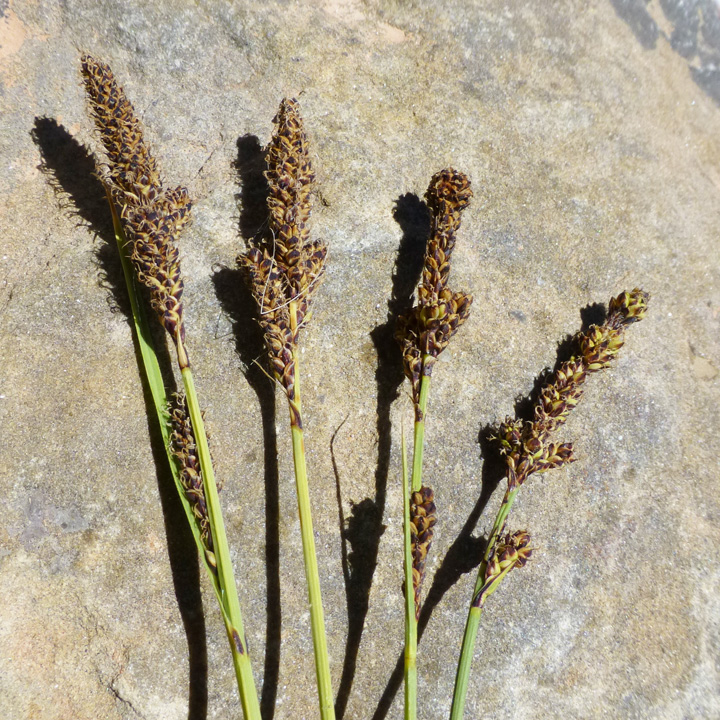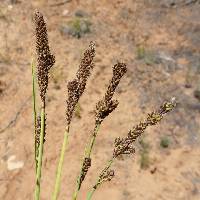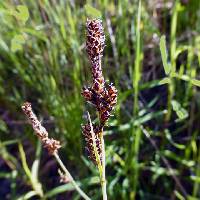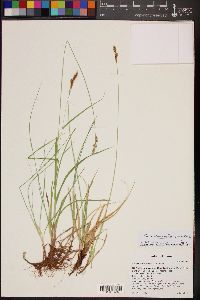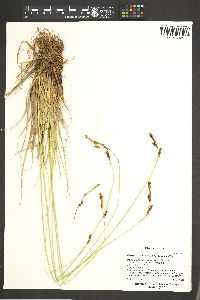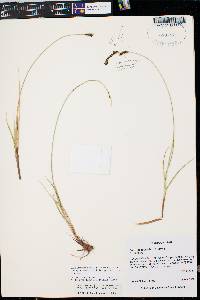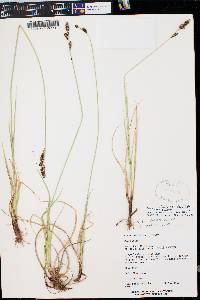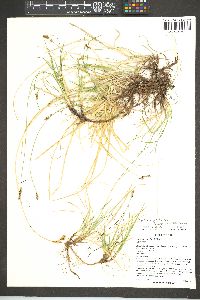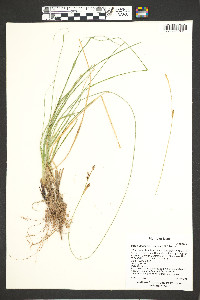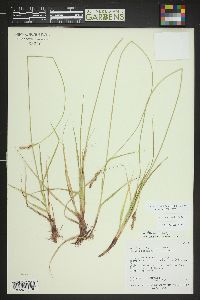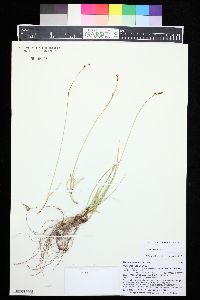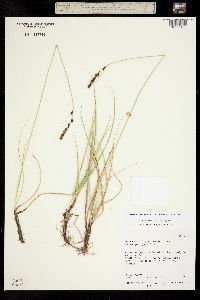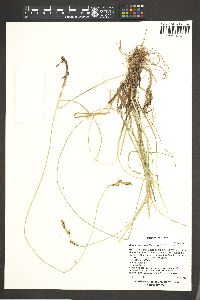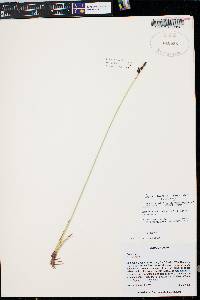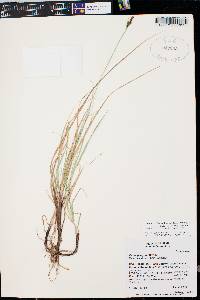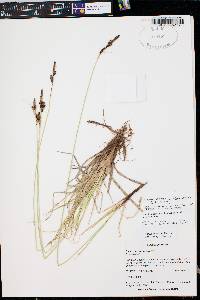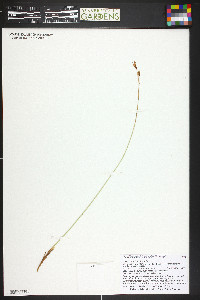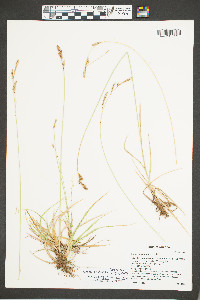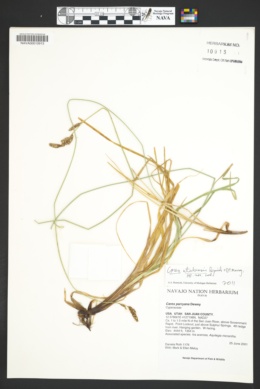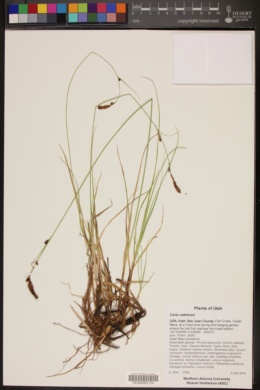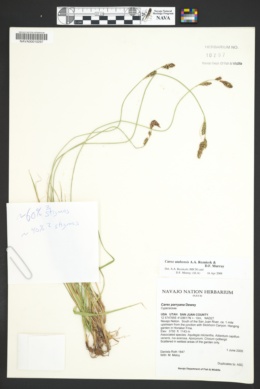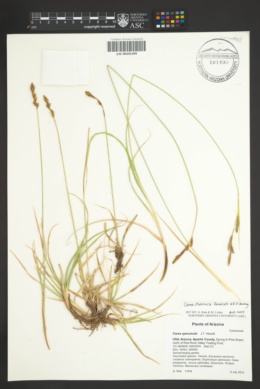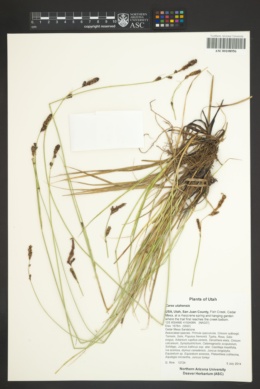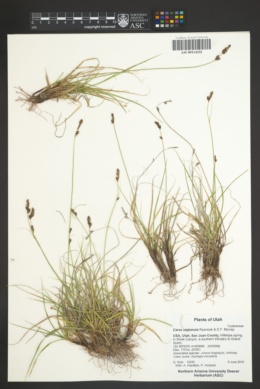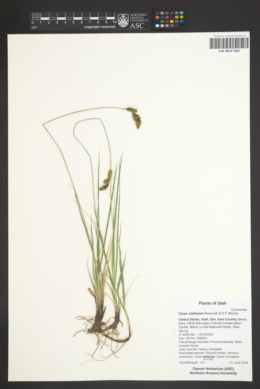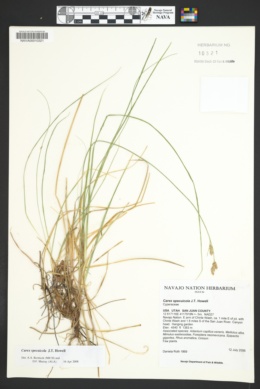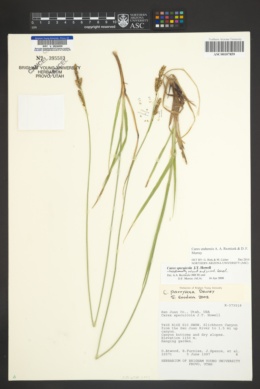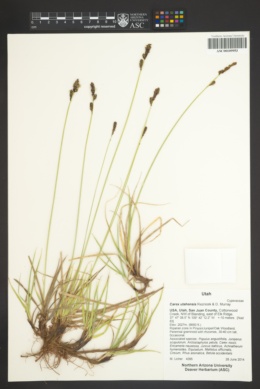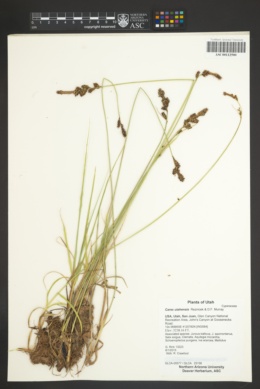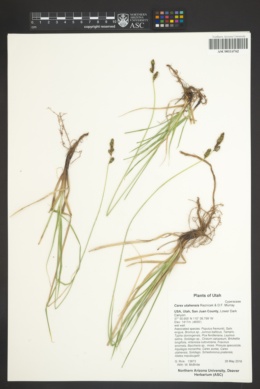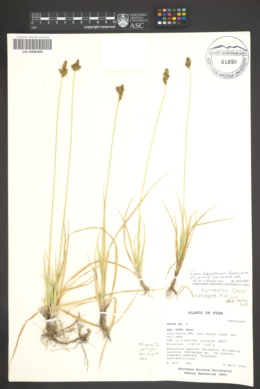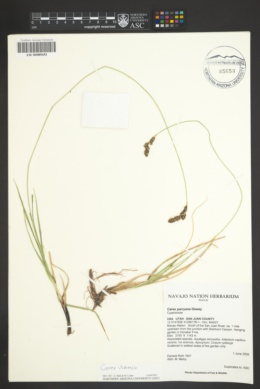Carex utahensis
|
|
|
|
Family: Cyperaceae
Utah Sedge
|
Carex utahensis: Loosely cespitose to colonial from ±elongate rhizomes 1.3–2.7 mm thick, rhizomes ca. 1–5 cm long between shoots, rhizome scales brown to purplish-brown, disintegrating into coarse fibers; culms 22–55 cm, stiff, ±erect, trigonous, papillose, 0.5–1.4 mm wide immediately below the inflorescence; phyllopodic, cataphylls and basal sheaths brown, the youngest often reddish-purple. Leaves 6 –12, essentially basal; blades 3.8–35 cm long, 1.8–4.5 mm wide, much shorter than culms, ±folded, margins and midrib smooth to finely antrorsely scabrous distally, ±smooth adaxially, papillose abaxially; leaf sheaths 1.7–15 cm long, glabrous, ventrally whitish or pale brown, hyaline, thin, shallowly concave at the apex; ligules ca. 0.8 –3.7 mm long, acute to rounded, shorter than wide, free portion whitish to pale brown. Inflorescences 2.4–8 cm long, with (2–)3–5(–6) spikes, terminal gy naecandrous or occasionally staminate, pistillate, or mixed, laterals pistillate; lateral spikes over-lapping or the lower separate, lower two spikes 1.3–3.3 cm distant, lowermost ±sessile or on a papillose peduncle up to 13.7 mm long; lowest bracts ±bristle-like up to 5 cm long and 1.8 mm wide, sheathless, upper bracts abruptly reduced. Terminal spike 12–31 mm long, pistillate portion (0–)3.7–19.2 mm long, 4.5–7.8 mm wide, ca. (0–)6–50-flowered, staminate portion (0–)6–24.5 mm long, 1.8–3.1 mm wide, ca. (0–)20 –65-flowered, peduncle 1.8–11.5 mm long. Lateral spikes 4–22.8 mm long, 3.5–6 mm wide, cylindric, densely flowered with ca.7–40 ascending perigynia. Staminate scales 2.3–3.7 mm long, 1.2–1.9 mm wide, obovate, reddish-brown to purple with narrow hyaline margins, especially distally, apex acute to obtuse or rounded, the green, 1–3-nerved center rarely prolonged into a ±scabrous-ciliate apiculus or short awn up to 0.5 mm long. Pistillate scales 1.9–3.3 mm long, 1.3–2.2 mm wide, reddish-brown to reddish-purple, hyaline margins inconspicuous, ovate to ±oblong, obtuse to acute, the green 1–3-nerved center sometimes prolonged into a scabrous-ciliate apiculus or awn up to 0.5 mm long. Perigynia 2.6 –3.9 mm long, 1.6–2.5 mm wide, ±strongly flattened to concavo-convex in cross-section, ±obovate, not filled by the much smaller achene, herbaceous, papillose distally, green to re ddish-purple di stally, greenish to brown proxim ally, 2 -nerved and frequently with a few faint nerves on the faces, tapering to a short stipitate base, contracted into an obscure to well defined cylindrical beak; beaks 0.1–0.4 mm long, papillose and sometimes setulose, green to purplish-brown, apex ±erose to obscurely bidentulate with teeth up to 0.1 mm long. Achenes 1.35–2 mm long, 0.9–1.3 mm wide, concavely tapering to a stipe 0.1–0.3 mm long, flattened-trigonous or sometimes lenticular in cross section; the convex sides narrowly elliptic in trigonous achenes, broadly elliptic in lentic ular achenes, brow n, smooth; apex usually apiculate with an apiculus up to 0.2 mm formed by the persistent style base; style deciduous; stigmas mostly 3, rarely up to 75% 2. Anthers 3, 1.8–2.6 mm long, often with a conspicuous apiculus ca. 0.1–0.3 mm long. Etymology.—From the state of Utah where the type collection is from. Seeps, wet slopes, alcoves and hanging gardens, wet meadows, and riparian bottomlands. Elevation 1400–3000 m. Endemic to Utah and adjacent westernmost Colorado. Plants treated a s C. parryana in Utah by Goodrich (in Welsh et al. 2003) and mapped by Albee et al. (1988) are this species and also C. holmgreniorum. Carex utahensis appears to be endemic to the northern portion of the Colorado Plateau. It is similar to C. specuicola in having achenes much smaller than the perigynia, the perigynia thus loosely fitting around the achene and not filled by it. But C. utahensis is a more stiffly erect plant, with darker pistillate scales, and opaque, green and clearly obovate perigynia distinctly purple tinged apically. Carex specuicola has a lax, arching habit, paler pistillate scales, and pale greenish, elliptic perigynia changing to whitish and translucent at maturity.
|

